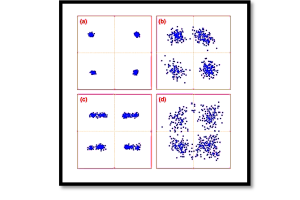
Amplitude Shift Keying (ASK): Theory, Spectral Response, and Performance Analysis
Amplitude Shift Keying (ASK) is one of the simplest and most fundamental digital modulation techniques. It forms the basis for several real-world applications such as RFID, optical communications, and low-cost wireless systems. In ASK, the carrier signal’s amplitude is varied to represent digital data. This blog explores ASK in-depth, including its variants like Binary ASK (B-ASK) and M-ary ASK (M-ASK), the spectral response of these signals, and their error performance.
Amplitude Shift Keying (ASK) Basics
In ASK, the amplitude of a continous carrier wave changes accourding to the digital data being transmitted. The simplest form of ASK represents binary data (‘0’ and ‘1’) by switching the amplitude of the carrier wave between two distinct levels. The general equaltion for an ASK signal is:

This method of modulating data by turning the carrier on or off is also known as on-off keying (OOK), a subset of ASK.
Characteristic of ASK:
- Simple implementatio: ASK modulation and demodulation are easy to implement with basic hardware.
- Noise Sensitivity: ASK is highly suscepible to noise because the information is encoded solely in the amplitude, making it vulnerable in low signal-to-noise ration (SNR) conditions.
- Bandwidth: The bandwidth required for ASK depends on the data rate and typically equals twice the bit rate.

Binary Amplitude Shift Keying (B-ASK)
In Binary ASK (B-ASK), the carrier signal can assume two distinct amplitude levels to represent binary data:
- A high amplitude A represents a binary ‘1’.
- A zero amplitude (or very low amplitude) represents a binary ‘0’.
The B-ASK signal can be expressed as:

Advantages of B-ASK:
- Ease of Implementation: Requires minimal hardware.
- Low Cost: Suitable for simple applications like remote controls and RFID systems.
Disadvantages of B-ASK:
- Noise Sensitivity: The signal is prone to errors in the presence of noise.
- Bandwidth Inefficiency: Requires a bandwidth equal to twice the bit rate, which is inefficient compared to other modulation schemes.
Spectral Response of Binary ASK
Time-Domain Representation:
A B-ASK signal is essentially a sinusoidal carrier modulated by a rectangular pulse train representing the digital data. If d(t)d(t)d(t) is the rectangular pulse representing the binary data, then the B-ASK signal is:

Frequency-Domain Analysis:
To analyze the spectral characteristics, we take the Fourier Transform of s(t). The resulting spectrum consists of:
- A main lobe centered at the carrier frequency fc.
- Side lobes due to the rectangular pulse nature of the data, resembling a sinc function.
The Bandwidth (BW) of the B-ASK signal can be estimated as: BW=2Rb
Where Rb is the bit rate.
This implies that the bandwidth of a B-ASK signal is twice the bit rate, making it less efficient compared to phase-based modulation schemes like PSK.

M-ary Amplitude Shift Keying (M-ASK)
In M-ary ASK (M-ASK), the carrier signal can assume M different amplitude levels, where M=2k and k is the number of bits per symbol. Each unique amplitude level represents a distinct combination of bits.
For example:
- 4-ASK uses 4 distinct amplitude levels to represent 2 bits per symbol.
- 8-ASK uses 8 amplitude levels to represent 3 bits per symbol.
Signal Representation: The M-ASK signal can be expressed as:

Advantages of M-ASK:
- Higher Data Rates: Transmits multiple bits per symbol, increasing the data rate.
- Bandwidth Efficiency: For a fixed symbol rate, M-ASK achieves higher data throughput.
Disadvantages of M-ASK:
- Complexity: Requires more complex hardware for generation and demodulation.
- Noise Susceptibility: As M increases, the amplitude levels become closer, making the system more prone to errors in noisy environments.
Symbol Rate and Bandwidth: The symbol rate Rs for M-ASK is:

Even though the bandwidth requirement is the same as B-ASK, M-ASK improves the data rate by transmitting more bits per symbol.
Probability of Bit Error (BER) in ASK
BER for B-ASK:
The bit error rate (BER) for Binary ASK in an AWGN (Additive White Gaussian Noise) channel is:

BER for M-ASK:
For M-ASK, the probability of symbol error Pseis:

Key Insights:
- Higher M results in higher BER for the same SNR due to closer spacing between amplitude levels.
- To achieve a low BER, M-ASK requires a higher SNR compared to B-ASK.
Take our entry level course (Below) for free using coupon code RAHRF101BLOG
RF Fundamentals, Basic Concepts and Components – RAHRF101
For limited time take an additional 10% off of all our courses using coupon code RFCERT10
Rahsoft RF Certificate and courses
Conclusion
Amplitude Shift Keying (ASK) is a simple and widely used modulation scheme. While B-ASK is straightforward and cost-effective, it suffers from noise sensitivity and bandwidth inefficiency. M-ASK improves data rates by encoding multiple bits per symbol but increases complexity and noise susceptibility.
Key Takeaways:
- B-ASK is ideal for low-cost, simple applications like RFID and remote controls.
- M-ASK is suitable for higher data rates but requires better SNR.
Understanding spectral response and error performance is crucial for designing effective ASK-based systems.

Learn more about this topic by taking the complete course ‘Introduction to Modulation in Communication Systems Online Course – RAHRF152’. Watch the course videos for more detailed understanding. Also checkout other courses on RF system and IC design on https://rahsoft.com/courses/. Rahsoft also provides a certificate on Radio Frequency. All the courses offer step by step approach.



